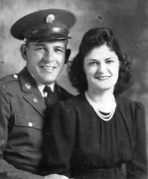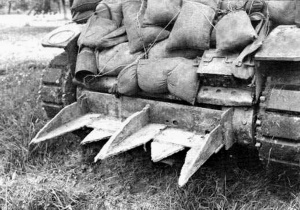Our search for the men of the 111th continues to run across odd little connections. The night before we left for Florida to meet Arthur Brooks (see previous posting), we received a phone call from Melissa Boaz of Austin, Texas. Melissa’s mother is the daughter of 111th member Joseph B. Apple, Jr., and she had received one of our letters. Melissa told us that her grandmother, Margaret Apple—Joseph’s widow—had passed away at the age of 95 just days before our letter arrived.
One of the things Melissa told us was that her grandfather was proud of the fact he was involved in the Allied effort to weld “prongs” onto the fronts of Sherman tanks in Normandy. (More on those in a minute.) After the war, Apple continued working as a welder in civilian life. He died in Texas in 1984.
A few days later, Art Brooks told us that one of their biggest jobs in Normandy was to fashion and sharpen pieces of scrap metal–left over from the destructive devices the Germans had placed on the beaches–into blades and weld them to bars on the front of tanks. This innovation allowed the tanks to plow through Normandy’s infamous hedgerows, “an important factor in achieving the St. Lo breakthrough,” Brooks added.
We interrupted and said, “We just learned all about that! One of your welders was Joseph Apple!” Brooks went on to say the job kept them busy day and night for a few weeks. They had to do their work under layers of camouflage netting so the Germans couldn’t see what they were doing.
In fact, Ed and I first learned about those cleverly adapted tanks while visiting the D-Day Museum in Caen, France, a few months ago. As you may know, the challenge for the Allies after they had secured the Normandy beaches was to continue to push the Germans inland. But they soon ran into the problem of bocage—the high, thick hedgerows surrounding the farm fields. The website www.tanks.net explains it well:
“In this environment, tanks and infantry became separated from one another. Axis soldiers would hide in the hedges and shoot Allied infantry with machine guns. The Allied infantry soldiers did not have tanks to protect them.
If a Sherman tank tried to ram through a hedge, it would become stuck in the hedge and the tank’s bow would get pushed up, making it the perfect target for a Panzerfaust anti-tank weapon.
“The Allies developed ram bumpers and hedgerow cutters to enable tanks to get through the hedgerows safely. The most famous of these is probably the Culin hedgerow cutter, which was invented by American Sergeant Curtis Grubb Culin III. The Culin Hedgerow Cutter was made up of sharp steel spikes that were fitted to the front of a tank. The cutter would cut through a hedgerow, creating an opening for the tank and the troops that followed. The steel for the Culin Hedgerow Cutter came from metal obstacles that the Germans had left on the beaches.”
The 111th, along with other Army ordnance units in Normandy in July 1944, were put to work fabricating and welding cutters onto Sherman tanks. Generals Eisenhower and Bradley later said that these modified tanks, also known as “Rhinos,” saved many Allied lives.



Ha! Nothin’ like American ingenuity huh?